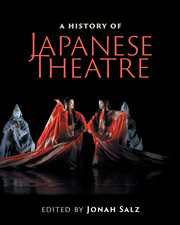Book contents
- Frontmatter
- Contents
- List of figures
- List of tables
- Contributors
- Contributors’ biographies
- Foreword
- Acknowledgments
- Note on Japanese terms
- List of abbreviations
- Timeline
- Editor's introduction
- I Traditional theatres
- Preface to Part I Japanese civilization arises
- II Modern theatres
- Preface to Part II
- III Arcs and patterns
- IV Theatre architecture
- Preface to Part IV Evolution of Japanese theatre architecture
- V Theatre criticism
- VI Intercultural influences
- Epilogue: Frozen words and mythology
- Further reading
- Index
- References
Epilogue: Frozen words and mythology
Published online by Cambridge University Press: 05 July 2016
- Frontmatter
- Contents
- List of figures
- List of tables
- Contributors
- Contributors’ biographies
- Foreword
- Acknowledgments
- Note on Japanese terms
- List of abbreviations
- Timeline
- Editor's introduction
- I Traditional theatres
- Preface to Part I Japanese civilization arises
- II Modern theatres
- Preface to Part II
- III Arcs and patterns
- IV Theatre architecture
- Preface to Part IV Evolution of Japanese theatre architecture
- V Theatre criticism
- VI Intercultural influences
- Epilogue: Frozen words and mythology
- Further reading
- Index
- References
Summary
My first contact with a Japanese theatre was in 1964: a book in French, Zeami's The Secret Art of Nō, translated by Réné Sieffert. It was one of those texts where words are frozen and only many years later thawed to life within me, acquiring a sense that matched my professional experience.
At the time, Japanese theatres – as well as those from other Asian countries – were totally disregarded in Europe. Almost no books or other sources of information were available about them and we came across them only as footnotes in historical books concerning legendary tours before World War II.
Only in 1972 did I have the opportunity to see the whole panoply of Japanese theatres – noh, kyogen, kabuki and shingeki. Odin Teatret, in a pioneering and rather monumental initiative, had invited to our Holstebro, Denmark home such masters as Kanze Hisao and brother Hideo, Nomura Mannojō, Sawamura Sōjūrō and Terayama Shūji with their ensembles – more than seventy artists. For over a week they gave performances and demonstrations on their apprenticeship and particular techniques. It was an overwhelming encounter. However, I felt I could not adapt what I had seen to my personal practice.
Encountering the spine
I don't speak Japanese and my possibility of dialogue with Japanese performers about their technique was non-existent. My knowledge of the various Japanese acting genres remained bookish and intellectual. Then I met nihonbuyo dancer Azuma Katsuko, who opened my eyes. She introduced me to her living technique, and her professional ethos. And she did this in such a way that what for me was previously abstract insight began to have a relevance to my personal practice and questioning.
During Odin Teatret's tour in Japan in 1980, professor and theatre director Watanabe Moriaki took me to watch Katsuko teaching children and shingeki actors who wanted to become familiar with her style. This close contact lasted only a few hours, but I fell irremediably in love with Katsuko's spine: I was enthralled by the way her torso was radiating energy in spite of stillness. She didn't speak English and I had to rely on the generous availability of Professor Watanabe. The consequence was that I invited them both to the first session of ISTA, the International School of Theatre Anthropology, which was to take place a few months later in Germany.
- Type
- Chapter
- Information
- A History of Japanese Theatre , pp. 536 - 538Publisher: Cambridge University PressPrint publication year: 2016



